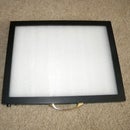Introduction: Random Pattern Opal Pendant
Here we are going to make this opal pendant with a random pattern background. I will also explain how to do several things that can be used on other projects. For instance, making a bezel for an opal, setting a faceted stone, & how to make a bail from scratch. So let's get into it.
Step 1: Gather Materials
I always start off with a good idea as to what materials that I want to use in a project. Here you can see just about everything I used to make this pendant. I want to teach the concept behind the pendant so you can take this & make other things not only just like this one.
I used:
20ga Sterling silver round wire
16ga Sterling silver round wire
Sterling silver flat strip wire in two widths
14k yellow gold, I sniped apart & melted into balls
14k yellow gold cup setting for the size stone I used
.09ct round diamond
Epoxy, two part adhesive
and of course a boulder opal doublet
Step 2: Tools
I have a wide array of tools that I can use, I know not everyone has as much. I try to keep the list as simple where I can. I used:
The little torch (brand name, but any torch that can melt silver will do)
Solder plate (I just use the non glazed side of a 6x6 tile)
Solder pick
Flex shaft or dremel
Pliers, several kinds (needle nose & rounded needle mostly)
Snips or cutters (Lindstrom Super-Flush Cutters is what I use)
Chasing hammer
A small anvil
Not shown but used:
Mandrel
Cotton muslin buffing wheel
Polishing compounds
Bench mounted motor for said cotton muslin buffing wheels
Sharpie
Pickle pot
Step 3: Making the Backgroung
Snip the thinner of the silver wire into smaller lengths. This does not have to be exact in any way. I have them in several sizes, & in different amounts in each size. You need enough, big/long enough to make the piece larger than the end size desired to be. I just drop them on the solder plate & see what happens. Not the best pattern on my first attempt. The second was better, but I still had a few that were off the others. If this happens just pick them up & add them where you think needs more material. Best results are achieved when you weld/melt the pieces together instead of soldering. Just heat where the pieces overlap & melt them into one another. Be careful not to melt too many of the ends into balled up pokies.
Step 4: Optional Hammer Flat
I like to hammer my pattern flat. You can skip this step if you like. Just will make a slightly different look.
Step 5: Make a Frame
Now you can make the piece look completely different by the frame that you add. You could add a rim around the whole pattern just the way it is, or cut it to fit a shape like I did. You could leave the frame off entirely. I like to lay my frame on top to see how it will look & mark with a sharpie where to make the cuts. Try to cut larger than your frame so you can file/sand for a tight fit. The tighter the fit the less solder you will need to hold it in. Now just solder on your frame.
Step 6: Bezel for Your Stone
Making a thin bezel like this one is not too hard. Just follow the contours of the stone & snip off where the pieces meet up. I normally weld the seam. This will help keep the joint from opening up when you solder it onto the piece later. The strip was too tall for my stone, so I had to grind/sand it down to size. I kept it a little tall so I can add a protective layer of clear epoxy later.
Step 7: Stone Placement
Figure out where you want your stones to be, or what looks like the best orientation. I soldered the bezel on first then the ring for the bail. I wanted good support for the stone so I placed it first, over a spot that had several wires inside the bezel. After I had those two figured out it was easy to place the cup setting for the diamond. I also added the gold balls here in random places.
Step 8: Time for a Bail
I used the wider flat strip wire for the bail. I first cut a length off then scribed the lines to show where to cut excess material off. After I trimmed it I curled it around a small mandrel I have to make a place for the chain/ribbon. Then I put it on the ring on top & soldered together. Now that all the parts are soldered on, this is the time to polish the spots that you might not be able to get to once the stones are set. This seems like a small thing but this is one of those steps that separates the average maker from the great ones.
Step 9: Stone Setting
Time to set the diamond. I use the flex shaft for this with a hart bur to cut the seats for the stone to sit into. When the stone is sitting well, bend the prongs down onto the top to hold it in. Then trim the prongs down & round off the tops.
Step 10: Final Polish
Wait, final polish now, but not all of the stones have been set yet. I know that we have not "set" the opal yet, but with a stone as delicate as opal you do that last. Also I do not want to polish the epoxy, that can make it cloudy or blacken it.
Step 11: Add the Opal
Like I said last thing is to set the opal. If you have done a good job forming the bezel then it should be a perfect fit. Mix up some two part epoxy & apply to the setting. next add the stone on top of that. I like to let my epoxy set up at least over night. I will come back & add another type of crystal clear epoxy over the top of the opal for protection. (which is why I left the bezel a little over the top of the stone.
That should be it. Wear with pride & show off your makings. As I said in the beginning, these techniques can be used in so many ways. Adapt them for your own needs, & have fun.

Participated in the
Jewelry Contest 2017













